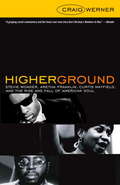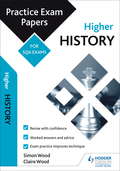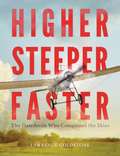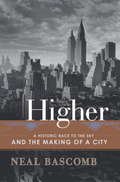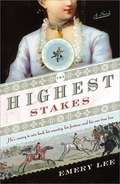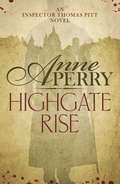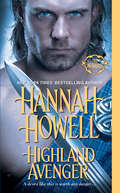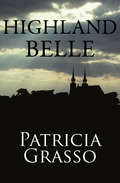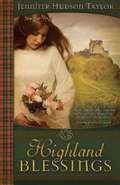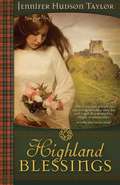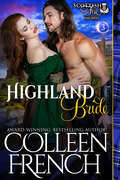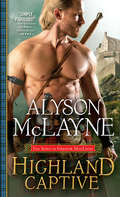- Table View
- List View
Higher Education: Patterns of Change in the 1970s (Routledge Library Editions: Education #15)
by John LawlorThis volume focuses on the changing pattern of tertiary education in the UK and the emphasis of the contributions is on the challenges and opportunities rather than the problems and difficulties of educationists at this level. The contributors are all leading figures in the educational world, and they are concerned in particular with the need for a partnership in the definition of aims and capabilities in higher education, in order to meet future needs. The potential of the (new) polytechnics and the use and interpretation of student/staff ratios, and the difficulties of interdisciplinary education are discussed.
Higher Education: Volume 39 (Higher Education: Handbook of Theory and Research #39)
by Laura W. PernaPublished annually since 1985, the Handbook series provides a compendium of thorough and integrative literature reviews on a diverse array of topics of interest to the higher education scholarly and policy communities. Each chapter provides a comprehensive review of research findings on a selected topic, critiques the research literature in terms of its conceptual and methodological rigor and sets forth an agenda for future research intended to advance knowledge on the chosen topic. The Handbook focuses on a comprehensive set of central areas of study in higher education that encompasses the salient dimensions of scholarly and policy inquiries undertaken in the international higher education community. Each annual volume contains chapters on current important issues pertaining to college students and faculty, organization and administration, curriculum and instruction, policy, diversity issues, economics and finance, history and philosophy, community colleges, advances in research methodology and other key aspects of higher education administration. The series is fortunate to have attracted annual contributions from distinguished scholars throughout the world.
Higher Education: Volume 40 (Higher Education: Handbook of Theory and Research #40)
by Laura W. PernaPublished annually since 1985, the Handbook series provides a compendium of thorough and integrative literature reviews on a diverse array of topics of interest to the higher education scholarly and policy communities. Each chapter provides a comprehensive review of research findings on a selected topic, critiques the research literature in terms of its conceptual and methodological rigor, and sets forth an agenda for future research intended to advance knowledge on the chosen topic. The Handbook focuses on a comprehensive set of central areas of study in higher education that encompasses the salient dimensions of scholarly and policy inquiries undertaken in the international higher education community. Each annual volume contains chapters on such diverse topics as research on college students and faculty, organization and administration, curriculum and instruction, policy, diversity issues, economics and finance, history and philosophy, community colleges, advances in research methodology, and more. The series is fortunate to have attracted annual contributions from distinguished scholars throughout the world.
Higher Ground: Stevie Wonder, Aretha Franklin, Curtis Mayfield, and the Rise and Fall of American Soul
by Craig WernerIn Higher Ground, one of our most insightful music writers brilliantly reinterprets the lives of three pop geniuses and the soul revolution they launched. Soul music is one of America's greatest cultural achievements, and Stevie Wonder, Aretha Franklin, and Curtis Mayfield are three of its most inspired practitioners. In midcentury America it was soul music--particularly the dazzling stream of recordings made by these three stars--that helped bring the gospel vision of the black church into the mainstream, energizing the era's social movements and defining a new American gospel where the sacred and the secular met. What made this gospel all the more amazing was that its most influential articulators were the sons and daughters of sharecroppers, storefront preachers, and single parents in the projects, whose genius gave voice to a new vision of American possibility. Higher Groundseamlessly weaves the specific and intensely personal narratives of Stevie, Aretha, and Curtis's lives into the historical fabric of their times. The three shared many similarities: They were all children of the great migration and of the black church. But the gospel impulse manifested itself in different ways within the dramas of their individual lives and musical creations. In Stevie Wonder's case, it was a literally color-blind universal sense of spirituality that expressed itself in his life and music as an urge toward transcendence, particularly in the mid-seventies when albums like Innervisions and Songs in the Key of Life radically revised what a pop album could be. For Aretha Franklin, the traditional gospel vision of a beloved community anchored in the strength of women comforted her through a life littered with tragedy and found expression in propulsive pop songs like "Respect" as well as in her legendary gospel albums. For Curtis Mayfield, the gospel notion of conscious living inspired him to create songs that served the purposes of the Civil Rights movement and the radical Black Power movement alike, from the gritty street drama of Superfly to the transcendent call of "People Get Ready." Werner doesn't just provide a narrative of three fascinating lives; he ties them together with a provocative thesis about American history and culture that compels us to reconsider both the music and the times. And aside from the personalities and the history, he writes beautifully about music itself, the nuts and bolts of its creation and performance, in a way that brings a new awareness and understanding to the most familiar music, forcing readers to listen to songs they've heard a thousand times with fresh ears. In Higher Ground, Werner illuminates the lives of three unparalleled American artists, reminding us why their music mattered then and still resonates with us today.
Higher History: Practice Papers for SQA Exams
by Claire Wood Simon WoodPractise for your SQA exams with three specially-commissioned Hodder Gibson Practice Exam Papers.- Practise with model papers written and checked by experienced markers and examiners- Get extra advice with specially-written study-skills guidance sections- Gain vital extra marks and avoid common mistakes with examiner tips
Higher Superstition: The Academic Left and Its Quarrels with Science
by Paul R. Gross Norman LevittThe widely acclaimed response to the postmodernists attacks on science, with a new afterword.With the emergence of "cultural studies" and the blurring of once-clear academic boundaries, scholars are turning to subjects far outside their traditional disciplines and areas of expertise. In Higher Superstition scientists Paul Gross and Norman Levitt raise serious questions about the growing criticism of science by humanists and social scientists on the "academic left." This edition of Higher Superstition includes a new afterword by the authors.
Higher and Colder: A History of Extreme Physiology and Exploration
by Vanessa HeggieDuring the long twentieth century, explorers went in unprecedented numbers to the hottest, coldest, and highest points on the globe. Taking us from the Himalaya to Antarctica and beyond, Higher and Colder presents the first history of extreme physiology, the study of the human body at its physical limits. Each chapter explores a seminal question in the history of science, while also showing how the apparently exotic locations and experiments contributed to broader political and social shifts in twentieth-century scientific thinking. Unlike most books on modern biomedicine, Higher and Colder focuses on fieldwork, expeditions, and exploration, and in doing so provides a welcome alternative to laboratory-dominated accounts of the history of modern life sciences. Though centered on male-dominated practices—science and exploration—it recovers the stories of women’s contributions that were sometimes accidentally, and sometimes deliberately, erased. Engaging and provocative, this book is a history of the scientists and physiologists who face challenges that are physically demanding, frequently dangerous, and sometimes fatal, in the interest of advancing modern science and pushing the boundaries of human ability.
Higher, Steeper, Faster: The Daredevils Who Conquered the Skies
by Lawrence GoldstoneDiscover the daring aviation pioneers who made the dream of powered flight a reality, forever changing the course of history. Aviator Lincoln Beachey broke countless records: he looped-the-loop, flew upside down and in corkscrews, and was the first to pull his aircraft out of what was a typically fatal tailspin. As Beachey and other aviators took to the skies in death-defying acts in the early twentieth century, these innovative daredevils not only wowed crowds, but also redefined the frontiers of powered flight. Higher, Steeper, Faster takes readers inside the world of the brave men and women who popularized flying through their deadly stunts and paved the way for modern aviation. With heart-stopping accounts of the action-packed race to conquer the skies, plus photographs and fascinating archival documents, this book will exhilarate readers as they fly through the pages.
Higher: A Historic Race to the Sky and the Making of a City
by Neal BascombThe Roaring Twenties in New York was a time of exuberant ambition, free-flowing optimism, an explosion of artistic expression in the age of Prohibition. New York was the city that embodied the spirit and strength of a newly powerful America. In 1924, in the vibrant heart of Manhattan, a fierce rivalry was born. Two architects, William Van Alen and Craig Severance (former friends and successful partners, but now bitter adversaries), set out to imprint their individual marks on the greatest canvas in the world--the rapidly evolving skyline of New York City. Each man desired to build the city's tallest building, or 'skyscraper. ' Each would stop at nothing to outdo his rival. Van Alen was a creative genius who envisioned a bold, contemporary building that would move beyond the tired architecture of the previous century. By a stroke of good fortune he found a larger-than-life patron in automobile magnate Walter Chrysler, and they set out to build the legendary Chrysler building. Severance, by comparison, was a brilliant businessman, and he tapped his circle of downtown, old-money investors to begin construction on the Manhattan Company Building at 40 Wall Street. From ground-breaking to bricklaying, Van Alen and Severance fought a cunning duel of wills. Each man was forced to revamp his architectural design in an attempt to push higher, to overcome his rival in mid-construction, as the structures rose, floor by floor, in record time. Yet just as the battle was underway, a third party entered the arena and announced plans to build an even larger building. This project would be overseen by one of Chrysler's principal rivals--a representative of the General Motors group--and the building ultimately became known as The Empire State Building. Infused with narrative thrills and perfectly rendered historical and engineering detail, Higher brings to life a sensational episode in American history. Author Neal Bascomb interweaves characters such as Al Smith and Governor Franklin Delano Roosevelt, leading up to an astonishing climax that illustrates one of the most ingenious (and secret) architectural achievements of all time.
Highest Duty: My Search for What Really Matters
by Jeffrey Zaslow Chesley B. SullenbergerThe inspirational autobiography of the hero pilot who landed a crippled flight in New York’s Hudson River—now a major motion picture starring Tom Hanks.On January 15, 2009, the world witnessed a remarkable emergency landing when Captain “Sully” Sullenberger skillfully glided US Airways Flight 1549 onto the Hudson River, saving the lives of all 155 passengers and crew. His cool actions not only averted tragedy but made him a hero and an inspiration worldwide. His story is now a major motion picture from director/producer Clint Eastwood and stars Tom Hanks, Laura Linney and Aaron Eckhart.Sully’s story is one of dedication, hope, and preparedness, revealing the important lessons he learned through his life, in his military service, and in his work as an airline pilot. It reminds us all that, even in these days of conflict, tragedy and uncertainty, there are values still worth fighting for—that life’s challenges can be met if we’re ready for them.“His fascinating and deservedly praised memoir reflects on his childhood love for planes and an outstanding 42-year career as a pilot—as well as how he and his family coped with the onslaught of sudden celebrity.” —Publishers Weekly
Highest Stakes
by Emery LeeIn the high stakes gentleman's world of 18th century horseracing, when the blood of the "desert kings" ruled the English turf, a hero returns from war to claim the girl he has loved since he first spied her riding hell-for-leather over the Doncaster heath. Determined to have her at any cost, he will risk everything. A story of star-crossed lovers and horseracing, THE HIGHEST STAKES transports the reader to 18th century England, an era infamous for corruption, arranged marriages, and high stakes gambling; when racing and breeding became the obsession of the uppermost elite, and a match race might replace a duel in settling a point of honor. Through the fictional love story of Robert Devington and Charlottte Wallace, a tale of drama, danger, thwarted love, and retribution unfurles...
Highgate Rise: A Charlotte and Thomas Pitt Novel (Charlotte and Thomas Pitt #11)
by Anne PerryClemency Shaw, the wife of a prominent doctor, has died in a tragic fire in the peaceful suburb of Highgate. But the blaze was set by an arsonist, and it is unclear whether she or Dr. Shaw was the intended victim—or did the doctor himself set the blaze in order to inherit his wife’s large fortune? Baffled by the scarcity of clues in this terrible crime, Inspector Thomas Pitt turns to the people who had been closest to the couple—Clemency’s stuffy but distinguished relatives. Meanwhile, Pitt’s wellborn wife, Charlotte, retraces the dangerous path that Clemency walked in the last months of her life, finding herself enmeshed in a sinister web that stretches from the lowest slums to the loftiest centers of power.
Highgate Rise: A cosy society is not as spotless as it seems… (Thomas Pitt Mystery #11)
by Anne PerryUnexpected clues and unexpected dangers... The death of the doctor's wife in a ferocious fire shocks genteel Highgate Village. But when it proves to be arson, Inspector Thomas Pitt finds himself in charge of a complicated case of murder, in Anne Perry's Highgate Rise. Perfect for fans of C. J. Sansom and Sarah Perry.'Perry uses her well-mannered prose, satiric wit and sense of place and time to construct a completely believable and human world. A sterling performance' - Library JournalClemency Shaw, the wife of a prominent doctor, is killed in a tragic fire in Highgate. But the blaze was deliberate, so was she or her husband the intended victim? Could the doctor have set it himself to inherit Clemency's large fortune? While Inspector Thomas Pitt tries to build a case from the scarce clues, his wife Charlotte retraces the dangerous path that Clemency walked in the last months of her life, finding herself enmeshed in a sinister web that stretches from the lowest slums to the loftiest centres of power. What readers are saying about Highgate Rise: 'This is a very satisfying book and I enjoyed it greatly''Taking book to work, can't put it down''Five stars'
Highland Angel (The Murray Brothers Series #7)
by Hannah HowellSir Payton Murray's reputation as a lover is rivaled only by his prowess with the sword, yet it is the latter gift that has captured the interest of Kirstie MacLye. Fleeing a murderous husband who left her for dead, she vows to expose the man for the vile scoundrel that he is.
Highland Angel (The Murrays #7)
by Hannah HowellSir Payton Murray's reputation as a lover is rivaled only by his prowess with the sword, yet it is the latter gift that has captured the interest of Kirstie MacLye. Fleeing a murderous husband who left her for dead, she vows to expose the man for the vile scoundrel that he is. She also knows it will take planning, cunning, and the help of a brave, arrogant, and willing champion. Kirstie only prays that Sir Payton will accept her challenge.Risking the ire of his own clan and hers, Payton nonetheless cannot ignore Kirstie's desperate plea or her captivating beauty. For he knows that nothing will deter the spirited lass from bringing an evil man to justice, even if she must do it alone. Joining her on this crusade, he embarks upon a dangerous quest against a powerful enemy only too eager to destroy them both. . . Praise For Hannah Howell And Her Highland Novels. . ."Few authors portray the Scottish highlands as lovingly or colorfully as Hannah Howell." --Publishers Weekly"Expert storyteller Howell pens another Highland winner." –Romantic Times
Highland Avenger (The Murrays #18)
by Hannah HowellA beautiful castaway finds safety in the arms of a Scottish Highlander in this historical romance by the New York Times bestselling author.Scotland, 1480. Once, Arianna Murray Lucette believed she'd met the man she could always rely on. But when her husband brought her home to France, she discovered how wrong she was. Now she is fleeing for her life, and when dangerous enemies attack a ship bound for her only refuge, she believes all hope is lost. Then she awakens on Scotland's shore to a pair of the most entrancing blue eyes she has ever seen. When Sir Brian MacFingal first spots the sun-streaked beauty on the beach, he mistakes her for dead. Soon, however, he discovers a woman full of life and vitality. But though he knows he is fit to defend her life—even at risk of losing his own—he must ask himself whether a raw warrior such as he could ever be worthy of her love.
Highland Barbarian (The Murrays #13)
by Hannah HowellNew York Times bestselling author Hannah Howell returns to the Highlands of Scotland for a sensual new series about two twin brothers both tempted and tormented by their passions--and driven by the love that will shape their destinies. . . Sir Artan Murray was right when he decided that the dying old man who bid him collect his niece didn't know her at all. The furious woman facing him is neither "sweet" nor "biddable." She demands the brawny Highlander return her to the wedding party from which he took her. But Artan has no intention of allowing so spirited and bewitching a creature to endure a loveless marriage to a ruthless lord for her clan's sake. He aims to woo the lass and to show her that true love also yields unforgettable pleasure. . . Cecily Donaldson knows a bond forged by danger and desperation cannot endure. But Artan's touch leaves her breathless, and she knows this to be her one chance to experience true passion before an arranged marriage seals her fate. Yet once begun, passion cannot be denied. . .nor can a love with the promise to change everything. . .
Highland Belle
by Patricia GrassoWed through an arranged marriage to a tyrannical Scot, Brigette Devereux picked up her pride and left. Her hair was red as a fox, her skin smooth as silk. Her pure complexion belied her fiery heart and her turbulent past. Her quest for freedom flung her straight into the embrace of Lord Iain MacArthur. She was rebellious; he was consuming. He was treacherous and she was no stranger to treachery. She was fair and he was darkness. Together they would set ablaze the time they had between them. Tossed from one tyrant to another, Brigette could not deny his evil ways nor could she deny her passion for him. His sweet-talking lips won her over and he brought his new bride to Dunridge Castle. But was this really a castle or would it be a prison? Before Brigette was willing to find out she fled again. From Scottish countryside, through highlands, across lakes and down-country through England to the shadowy streets of London, Lord Iain MacArthur would chase his prize and Brigette would flee the man who loved her. She was a free spirit and he was driven to capture her heart!
Highland Betrayal (The Sons of Gregor MacLeod #3)
by Alyson McLayne"Witty banter, adventure and passion!"—ELIZA KNIGHT, USA Today bestselling authorA betrothal. A betrayal. A love threatened by treachery.Laird Callum MacLean vowed to marry Maggie MacDonnell. But when his father's apparent suicide makes him Laird of his clan, Callum must unmask his father's killer before bringing Maggie into his dangerous new home. Maggie's home isn't any safer. When Callum fails to return, Maggie does what any resourceful Highland lass would do. She escapes—and finds herself toe-to-toe with Callum, who's determined to fulfill his promise. Maggie can't bring herself to trust him with her heart again. But with a traitor still at large, they must rely on each other in every way, or their clans—and their love—will be destroyed.The Sons of Gregor MacLeod:Highland Promise (Book 1)Highland Conquest (Book 2)Highland Betrayal (Book 3)More praise for McLayne's Sons of Gregor MacLeod:"Raises the bar of Scottish-set historical romances."—BookPage"You'll be captivated by the humor, passion and adventure."—RT Book Reviews"Expertly crafted... [a] page-turner."—Publishers Weekly
Highland Blessings
by Jennifer Hudson Taylor2011 Holt Medallion Award Winner - Best First NovelHighland Blessings is the story of a highland warrior who kidnaps the daughter of his greatest enemy and clan chief to honor a promise he made to his dying father. Bryce MacPhearson, a highland warrior, kidnaps Akira MacKenzie on her wedding day to honor a promise he made to his dying father. While Akira's strength in the Lord becomes a witness to Bryce, she struggles to overcome her anger and resentment when he forces her to wed him, hoping to end a half-century-old feud between their clans.While Akira begins to forgive, and Bryce learns to trust, a series of murders leaves a trail of unanswered questions, confusion, and a legacy of hate that once again rises between their families. Clearly, a traitor is in their midst. Now the one man Akira loves no longer trusts her, and her own life is in danger. Can Bryce look beyond his pain and seek the truth? Will Akira discover the threat against her before it's too late? How will God turn a simple promise into bountiful Highland blessings?
Highland Blessings
by Jennifer Hudson Taylor2011 Holt Medallion Award Winner - Best First Novel Highland Blessings is the story of a highland warrior who kidnaps the daughter of his greatest enemy and clan chief to honor a promise he made to his dying father. Bryce MacPhearson, a highland warrior, kidnaps Akira MacKenzie on her wedding day to honor a promise he made to his dying father. While Akira's strength in the Lord becomes a witness to Bryce, she struggles to overcome her anger and resentment when he forces her to wed him, hoping to end a half-century-old feud between their clans. While Akira begins to forgive, and Bryce learns to trust, a series of murders leaves a trail of unanswered questions, confusion, and a legacy of hate that once again rises between their families. Clearly, a traitor is in their midst. Now the one man Akira loves no longer trusts her, and her own life is in danger. Can Bryce look beyond his pain and seek the truth? Will Akira discover the threat against her before it's too late? How will God turn a simple promise into bountiful Highland blessings?
Highland Bride (Scottish Fire Series #3)
by Colleen FrenchTo unite their clans, Kara Gordon is bound by a marriage contract to the McKie family. But when her intended dies in a bloody mountain skirmish, she is forced to marry his heir and younger brother, Henry, a mere twelve-year-old boy. Fearing their union--and its consummation--Kara is relieved that the new earl is more in need of a mother's care than a lover's touch.Yet one man longs for Kara's caress--Henry's advisor, protector, and half-brother--Ian. As Ian's attraction to Kara dares to flame into scandalous desire, enemies inside and outside the castle fight to remove Henry from the throne--by any means necessary.But Kara, who has never once known the love of another, cannot deny her fiery passions. Only Ian's undying devotion can embolden her to face the future--one that may destroy everyone she holds dear.SCOTTISH FIRE SERIES, in orderHighland LadyHighland LordHighland BrideAWARDS:Delaware Diamond Award for Literary ExcellenceP.E.A.R.L. Award
Highland Bride (The Murrays #6)
by Hannah HowellReturn to medieval Scotland in New York Times bestselling author Hannah Howell&’s beloved and long-running iconic series featuring the proud, unforgettable men and women of the Murray clan. Reissued for the first time in over a decade! Though she has yet to be courted by any man, spirited Gillyanne Murray decides the time has come to visit the dower lands gifted to her by her father's kinsmen. She arrives to find the small keep surrounded by three lairds, each one vying for her hand . . . and her property. Though resolved to refuse them all, the threat of battle on her threshold forces her to boldly choose a suitor: Sir Connor MacEnroy, a handsome, daring knight of few words. As Connor&’s wife, Gillyanne is stunned by his terse, cold distance—and her own yearning to feel passion in his arms. Now, bringing her healing touch to a land and a keep ravaged by treachery and secret enemies, she dares to reach out for the one thing she fears she may forever be denied . . . her husband's closely guarded heart.
Highland Captive
by Hannah HowellNew York Times bestselling author Hannah Howell breathes life into the enchanting beauty of the Scottish Highlands in this epic romance between a strong-willed captor and the striking young woman he both confines and protects . . . The windswept Scottish Highlands hold great beauty, but also great danger. So when Aimil Mengue is abducted by a feuding clan, she is right to fear for her life—and her virtue. For Aimil&’s keeper is the infamous warrior Parlan MacGuin. Aimil sets out to hate him, but Parlan is more honorable—and infinitely more alluring—than expected. Though betrothed to another, Aimil cannot deny her startling desire for the man who holds her captive... Parlan MacGuin knows well his reputation as a fierce warrior; he uses it to claim land and lovers. But beautiful Aimil is a different type of conquest. Now Parlan feels an unfamiliar longing for the woman he keeps at ransom as their forbidden passion threatens to spark an unstoppable blood feud—or forever fill their hearts . . .
Highland Captive (The Sons of Gregor MacLeod #4)
by Alyson McLayne"Expertly crafted... [a] page-turner."—Publishers Weekly for Highland ConquestShe'd saved his son. Could she save him as well?Laird Gavin MacKinnon is a changed man—and not for the better. Ever since his young son, Ewan, disappeared two years ago, Gavin has grown callous and bitter. Scouring the countryside, his search leads him to a mysterious woman who maintains the boy is hers. He decides to take them both and ask questions later. Deirdre MacIntyre will go with the brooding laird if it will keep her son safe. Gavin has to admit that the beautiful lass has a bond with Ewan, and things aren't adding up. When Deirdre's clan comes to claim her under threat of war, Gavin has a choice to make: fight for her or let her go. The Sons of Gregor MacLeod: Highland Promise (Book 1) Highland Conquest (Book 2) Highland Betrayal (Book 3)Highland Captive (Book 4)More Praise for Alyson McLayne's Songs of Gregor MacLeod Series: "Not to be missed. Alyson McLayne's writing is simply fabulous!"—Night Owl Reviews Top Pick, 5 Stars, for Highland Betrayal "You'll be captivated by the humor, passion and adventure... Entertaining from beginning to end."—RT Book Reviews, 4 Stars, for Highland Conquest "Suffused with witty banter, adventure and passion!"—ELIZA KNIGHT, USA Today bestselling author of the MacDougall Legacy series, for Highland Promise "Raises the bar of Scottish-set historical romances."—BookPage for Highland Promise "Adventure, passion, and hot Scots."—Booklist for Highland Promise



